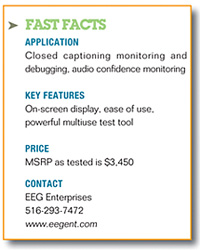There was a time when most closed captioning issues around a TV station or production facility could be solved by using a waveform monitor. You just selected "line" viewing mode and scrolled up to line 21—you either had active CC or you didn't. There was no need to consult an off-air receiver or anything else.

EEG's Model DE 285 With the transition to DTV, most troubleshooting techniques have changed, and this is the case with closed captioning. The TV set in my office tells me if our CC is working or not; however, it doesn't have a SMPTE 292 input, which means I can't connect up to the station's tech core and probe around until I find the problem. That's where a professional CC/VANC data monitor is needed. EEG, the captioning experts in Farmingdale, N.Y., offer just the product to help troubleshoot CC, AFD, and a variety of other data signals contained in the DTV stream.
FEATURES
The 1RU EEG DE285 both decodes captions and provides CEA-708, metadata, as well as VANC data selections for display. It can display caption data in HD Services 1 through 6, as well as EIA-608 captioning and compatibility bytes. In addition to captioning data, it also decodes AFD, audio metadata, XDS, and provides embedded audio decoding, complete with channel levels, peaks, and phase detection. The DE285 comes with a browser-based VANC analysis tool for viewing and capturing live VANC data. This can be sorted by service type, DID/SDID or line number, and the Web tool offers programmable triggers with logging for packet dropouts or changes. It accepts SMPTE 292 standard signals, including 1080i, 720p, 480p, 24 fps, and 270 Mbps SD. Connectivity is via USB and Ethernet ports, with a DB-25 connector for GPI/O. In case a problem should develop, there's relay bypass protection for video.
IN USE
Setting up the DE285 up for action was a breeze—I only had to supply AC power and a clean 1080i feed. At power-up, the unit's LCD display indicated a signal was present, and when I viewed the device's output feed on a picture monitor, I was rewarded with a cornucopia of information.
Displayed over the left side of the HD image was an XDS (Extended Data Services) window, indicating "Invalid Rating" on NBC's "Today" show which was arriving at that time. There was a box a bit further down on the left side that indicated the presence of AFD and the various aspect ratio parameters. The bottom of the screen featured a large window displaying closed caption text, while in the top right corner of the picture was a window indicating that the on-screen display selected was "Service 1" (708), and that both 608 and 708 information was present. There was also a nice surprise over in the bottom right corner—a window for the monitoring of up to eight audio channels; 5.1 and two more. The bargraph level meters generated had peak hold indicators, as well as phase displays for stereo pairs.
While this little box had my attention with just what I was seeing on the picture monitor, I figured it was time to try out some of its Web-based features. I connected a laptop computer and entered the provided IP address into the browser address box. After hitting "Enter" on the PC, I had a nice EEG ancillary data monitor banner running across the top of my computer screen. Tabs were provided under the banner for selecting different options. These included a packet display with data packets, service type, line numbers, and frequency displayed in a scrollable fashion. The next tab was "Data Decoder" with AFD information, and decoded XDS information. Another window was available for display of any detected errors, as well as for video format, and system info.
By the time I'd established IP connectivity, the "Today" show had ended, so I routed in a "Dr. Phil" feed. The DE-285's "Data Decoder" tab told me that this program had no AFD, was episode 9018, was rated TV-14L, and that copying was permitted. The next tab was the "Caption Decoder," which provided a quick view of available services.
I then checked out another tab labeled "ANC Trigger." This allows the operator to set up automatic triggers in two steps. The first allows selection of the data of interest via a provided dropdown list; the second sets the state you might be searching for as either "present" or "absent."
I found the "ANC Trigger" page easy to navigate, and once selected, there's a large "start" button on the right-hand side. The next tab is designated "VANC Capture." This allows a real-time capture of VANC data (filtered or not), that can be downloaded and saved. There's also a box for selecting filters, a start button, and an elapsed time display. A "logging" tab allows the unit to display and save alarm/trigger data for in-depth analysis, debugging, and printing. The "OSD" tab revealed the toolset for customizing the on-screen display.
The final tab I evaluated was "Settings." It allows DE-285 upgrades, provides loss of CC data alarm setup, date and time entry, factory default selections, and various other housekeeping duties for the DE-285.
SUMMARY
I kept the DE-285 hooked up and running for several weeks, and my whole staff was impressed with it. During the test period, the unit performed flawlessly and operation was a breeze. Brevity necessitates that I mention only the highlights of the DE-285's many features. While I didn't exercise every function that the box offers, what I did try was quite impressive. It's a nice combination of audio and CC monitoring.
Joey Gill is chief engineer at WPSD-TV in Paducah, Ky. and has been with the station for 30 years. He has worked in television since 1977. He may be contacted at respond2jgill@yahoo.com.

The professional video industry's #1 source for news, trends and product and tech information. Sign up below.
